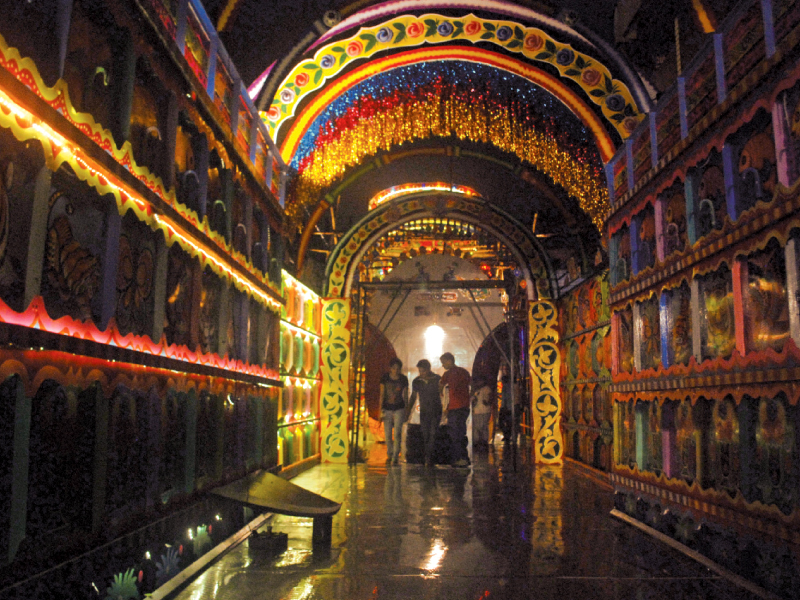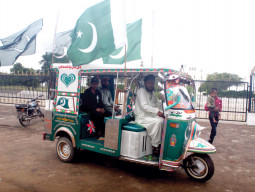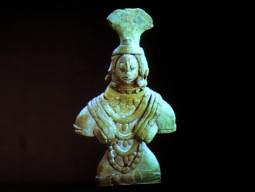
KOLKATA:
For long, Bengal has had a direct link with Pakistan — the Grand Trunk Road that connects Howrah with Peshawar. The “road connection” has only got stronger with Karachi’s truck artists bringing to life a Durga Puja pandal (a makeshift structure set up to venerate a god) in Kolkata this autumn.
A team of Pakistani truck artists have decorated the Nabin Pally Durga Puja pandal, tucked away in one of the narrow lanes of north Kolkata, with their phool-patti paintings in styles from Karachi, Peshawar and Rawalpindi. A phantasmagoria of images, their work is a riot of colours and motifs of trees, flowers, leaves and birds — all the objects that a truck driver is likely to encounter — and geometric shapes.
Tension along the border has escalated and the premiers of Pakistan and India would not see eye to eye when they met at the United Nations. But Pakistani artist Haider Ali and his teammates Mumtaaz Ahmed and Muhammad Iqbal have been blurring the lines of sarhad (border) and mazhab (religion) with their paintbrushes in this “city of joy” over the past five weeks.
The structure of the pandal has been made to make the visitors feel like they are standing inside the cargo hold of a long and empty truck. The truck-art painting is done on the interior and the taj (the front portion of a typical Pakistani truck that juts out at an angle) is flipped to face the visitors and adorns the top of the ‘sanctum sanctorum’. Goddess Durga with her family of gods and goddesses, made of copper and brass by Kolkata artist Gopal Poddar, are placed there.
Typically, the festival begins on Saptami, the seventh day of Navratri observed all over India through nine days. However, nowadays in Bengal the festivities have been extended with a “soft-beginning” on Panchami and Sashthi (the fifth and sixth days).
Sashthi, the sixth day of the month, falls today (Thursday), but there’s a steady stream of visitors already on Wednesday.
With work finally over, the artists in their shalwar kameezes relax in the antechamber of the pandal. The wait is now for the river of humanity to flow into the pandal.
“Cha khaben?” Haider Ali asks in Bengali, offering tea to visitors. “It’s been great fun. The people are nice, so are the rasgullas,” he adds in Urdu. Kolkata biryani was a bit of a dampener—“not as spicy as ours.”
When they crossed Wagah borders, the internationally acclaimed truck artists from Karachi had little idea about Durga Puja. “We’d heard of Diwali but had no clue of Durga Puja,” says Ali. “We were thinking, we’d be painting a truck. Pandal was a pleasant surprise,” says the artist whose truck-art have been showcased in the US, Canada and Europe.

Celebrated in autumn every year, Durga Puja is the biggest festival in Bengal and one of the biggest in Asia. The festival celebrates the victory of Goddess Durga over buffalo demon Mahishasura—of good over evil.
Durga idols are worshipped in the pandals. On the tenth day of Vijavadashami, or Dusshera, they are taken around in a procession and immersed in water bodies in a ritual called Bisarjan.
Despite the religious nature of the festival, the Durga Puja is more a cultural melting pot, with five days of revelries—food, music, new clothes, cultural events and addas, animated discussions that Bengalis are known for.
The main draw, however, is pandal-hopping. Hundreds of people, in brand new clothes, flock from one place to another to check out the idols and the pandal work put together by artists and craftsmen. Some Kolkata pandals see as many as three to four million footfalls in those five-six days. Leg-ache assumes epidemic proportions with extended waits in queues and long marches on off-traffic roads.
Kolkata alone has more than 3,000 community Durga pujas, apart from many bari (household) pujas. Needless to say, general life comes to a standstill.
Every year, Puja organisers in Kolkata line up new themes— terrorism, cricket, cinema et al. Art-styles and materials used are wide ranging— pandals made of bhad (earthen cups used to drink tea, also called kulhars), leaves, jute, hay, wood, tiles, clay and just about anything—bringing together wood-carvers, painters, and craftsmen.
This year, while French and Bengali artists are collaborating to put together a theme of 100 years of Bollywood in one pandal, visual artist Sanatan Dinda is working on the theme of ananda (joy) in another.
“Our theme this year is India-Pakistan friendship,” says Jayanta Chaudhuri, vice-president of Nabin Pally Puja Committee. “We had heard about Pakistan’s truck art and contacted the artists almost a year ago. We want people in large numbers to come and see their work and develop fond feelings for our neighbour,” he adds.
“The common people want peace and friendship. It’s only the politicians who love spreading hatred,” says Ali. For a resident of Garden in Karachi, crossing the border is also a homecoming of sorts. His father Muhammad Sardar, from whom he learnt truck art as a child, had migrated with his family from Jalandhar, India, during Partition.
Would he like to come back? “Oh yes, I want to paint the Kolkata trams.”
Published in The Express Tribune, October 10th, 2013.
COMMENTS (6)
Comments are moderated and generally will be posted if they are on-topic and not abusive.
For more information, please see our Comments FAQ























































Awesome. Loved it
Well done! I hope the Kolkatta folks enjoy the art. It's thru art like this that understanding each other happens.
I wish Indian artists would reciprocate this gesture and help design banners for Eid celebration in Pakistan.
Kolkata is the art and culture capital of India. All the big names you hear, Tagore, Satyajit Ray, Amartya Sen, Ravi Shankar, Kishore Kumar, Geeta Dutt, even Ustad Alauddin Khan, Vilayat Khan, Ali Akbar, all Bengalis. Now even Pakistani truck art is a part of the great tradition. Congratulations!
Thanks Raj, that what we both nations need from each other
how sweet ...thanks for the decoration....come again to paint the trams.. :)